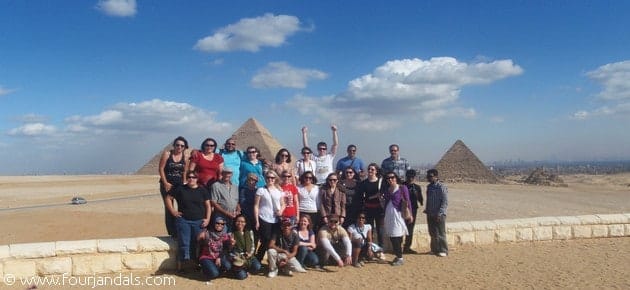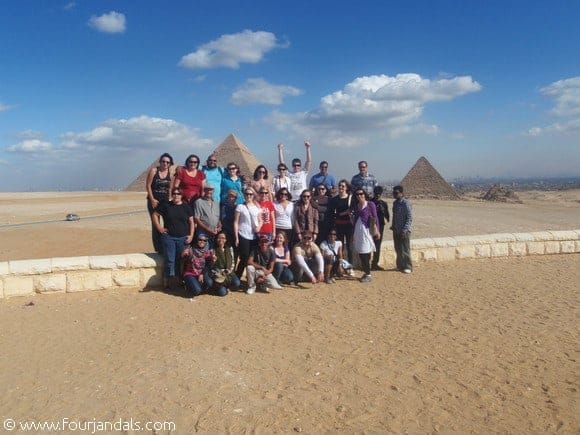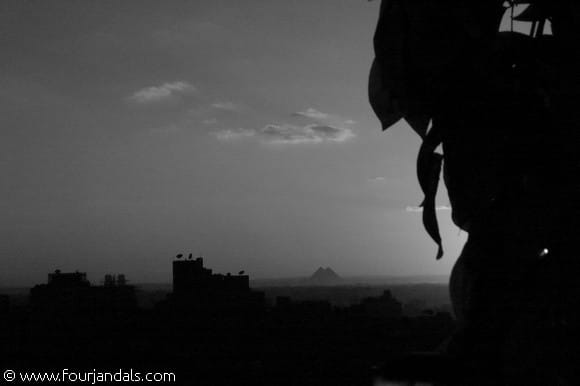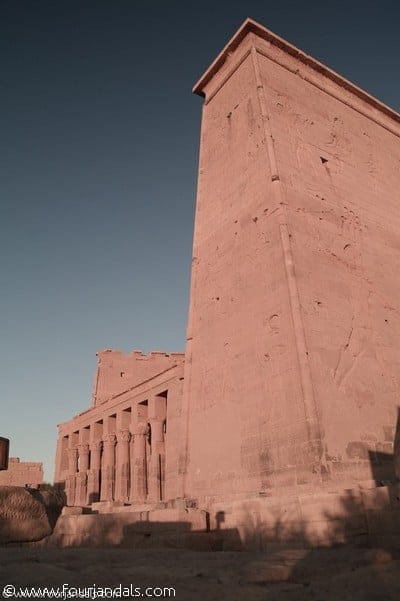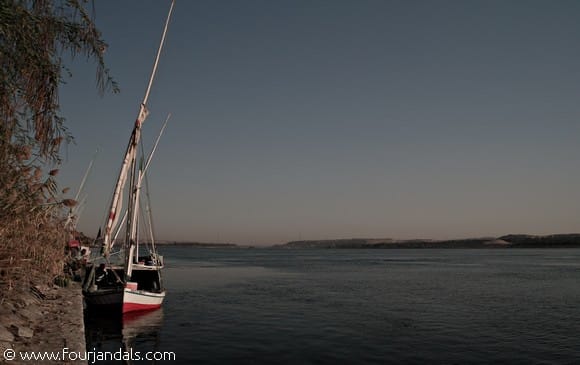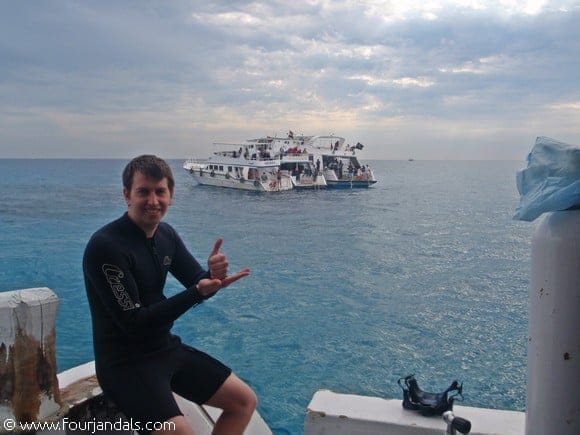We have wanted to visit Egypt for a while now, so when the opportunity to get away over the Christmas and New Year period arose, we knew we needed to head there for a break. We joined Expat Explore on their 10 Day Explorer Tour through Egypt, taking in the sights of Cairo, Aswan, Luxor, and Hurghada.
Expat Explore Ten Day Egypt Explorer Tour Review
We chose Expat Explore because they were the cheapest with all the same sights and in the end, we were happy with our choice.
Pre-departure, they emailed us our itinerary with the optional excursions and additional costs for entry fees, including budgeting appropriately. As well as following up with our pre-trip questions regarding flights, insurance, and health and safety advice.
From the start, they were very professional. Landing in Cairo, we were personally greeted the day before our tour and transported to our City center hotel. That drive was an eye-opener to Egypt with crazy lane changes, honking, swerving, and flashing lights with animals, people, and vehicles everywhere.
El Tonsy Hotel is your base for your arrival and last night. Luckily we didn’t expect much as our door didn’t lock, which was a bit dodgy, and the rooms were cold with a broken heater and only one blanket. You wouldn’t think you would need heat in Egypt, but it was the middle of winter, chilly at night. No complaints with the location, though, as we could see the Pyramids in the distance and were only 5 minutes walk from the Nile and 15 minutes to Tahir Square (perfectly safe, by the way). Plus, they have a little bar/restaurant with cheap food and free Wi-Fi. Just buy your snacks and water from the supermarket across the road, and you will get on fine.
It’s pretty hard to break down a whole trip into one post but here goes:
Day One
Your tour starts with the best in my opinion by touring some sights of Cairo. The steeply angled Step Pyramid, the mind-blowing Pyramids of Giza, and the smaller than expected Sphinx. This day was the highlight.
That night is spent aboard the train for 10-12 hours to Aswan. I highly recommend the Sleeper train for an extra £50 per person. Others who caught the standard train froze their butts off while we had a toasty sleep with dinner and breakfast. Unfortunately, Expat Explore never told us about the provided food, so we ate before we got on board but what we could fit in was delicious.
Day Two in Egypt
The tour splits in Aswan as one group embarks on a River Cruise aboard a 5-star ship while the others spend time in hotels and on a Felucca. No surprise that we went with the cheaper option aboard the Felucca, so the next few days are from that point of view.
The afternoon is yours at Sara Hotel on the banks above the Nile. We lapped up the beautiful rays of the sun and managed to turn our pasty white bodies a more fitting, slightly white shade. The Hotel was great until the toilet next door erupted, sending a river of smelly waste across our bedroom floor (throw your toilet paper in the bin, not the loo)! Luckily we woke in time to rescue our bags from the watery mess! Not the fault of Expat Explore, and we didn’t blame the Hotel either, as shit happens.
Day Three on the Nile River
Your day begins by visiting the monstrous High Dam for 10 minutes (reasonably boring) and driving past the Unfinished Obelisk. At the same time, the highlight is the Philae Temple. It is pretty magical when the sunsets across the Nile reflect off the stonework.
The evening ended with an optional dinner in a traditional Nubian family’s house. The food was delicious, and you better bring your singing and dancing shoes.
Day Four on the Felucca
The following day and night are spent relaxing aboard the Felucca for a sail up the Nile for several hours. Sleeping no more than eight people, you will be snug if you bring your sleeping bag like us. The rest of our crew was jealous as it did get quite chilly in the evening. However, blankets were provided.
With delicious pita bread and falafel cooked on the boat, you will not be disappointed with the food either.
The day ends with a bonfire on the Nile shoreline as you sing and dance with the crazy fun Nubian crews. This was one of the highlights of the entire trip for us.
Travel Tip: Don’t be put off by doing your “business” amongst the reeds of the Nile. Just enjoy the view and remember to bring your toilet paper (which you need everywhere in Egypt anyway).
By all accounts, from the other tour members, the River Cruise is just as great, with three nights onboard in comfortable accommodation, a pool, and buffets morning, noon, and night.
Day Five Temple Exploring
Waking to a sunrise breaking the morning chill is a glorious way to start a new day. Unfortunately, there is little time for relaxation before you are off the Felucca and on a bus to Kom Ombu and Edfu Temples. The transportation was more than adequate, with toilets on the buses and room enough for everyone. It’s lucky because you spend most of the time being driven around.
The Lotus Hotel in Luxor was probably the pick of them all. It was situated on the Nile bank with a swimming pool and a tasty buffet breakfast.
Day Six at the tombs
One more day, one more busy schedule. Rushing to beat the crowds at the Valley of the Kings, it’s another 8 am start. You are only allowed to visit three tombs, and we recommend the guide picks: Ramses II, IV, and IX.
Travel Tip: You are NOT allowed to take your camera with you off the bus. Please don’t ruin it for everyone by taking photos, as you will be charged by security when caught.
We also squeezed in the crowded rock-carved Hatshepsut Temple but only drove past Luxor Temple as we ran out of time as you need to go 6 hours to reach Hurghada that night.
Day Seven and Eight at the Red Sea
The following two days at the Red Sea are yours to do whatever you like, so use them wisely. We joined most of our group for a spot of snorkeling and diving. The dive and the staff were great, but the whole day seemed a little rushed, which was a shame. Keep an eye out for our post on our diving experience in Hurghada.
So nice being able to relax on a beach and read a book after such a hectic schedule. It’s hard to leave, and the 6 – 8 hour bus ride back to Cairo is challenging.
Travel Tip: If you plan to do the tour over New Year’s Eve, you will have to depart Hurghada half a day early, which sucked as it meant celebrating the New Year at the Hotel in Cairo. Bit of a letdown, but when hasn’t New Year’s Eve been!
Day Nine in Cairo
Your final day of sightseeing is spent around Cairo. Our favorite part of the day was the Cairo Museum with an excellent tour guide. It fits perfectly at the end by seeing all the history close-up after learning about it over the last eight days.
By the time we hit the old area of Cairo and the Coptic Hanging Church, we were spent on history, but our guide made a reasonable effort at keeping us entertained.
The last group activity is free time for an hour or so at the Khan El Khalili souk markets, where the touts try to prise your cash from you for the last time from every nook and cranny.
Day Ten is the end
With the tour over, it’s time to head home. Our flight was late the following night, so we walked around the city and Souks on our own for the day. Expat Explore provides transport back to the airport, which was great.
The Negatives of Egypt Travel
The trip was fantastic, but we think it’s important to note the little things that could make a massive difference to the overall experience:
- It felt like we were always hungry. Maybe it is just Kiwis and Aussies that eat all the time, but it seriously felt like we were constantly starving, with lunches being served usually after 4 pm and dinner at 9 pm onwards. It might be the Egyptian way to eat at those times, but not for us. Travel Tip: Buy lots of snacks for the road which are very cheap at supermarkets.
- There was sometimes a lack of direction in what seemed to be happening. Everything is done in Egyptian time, so be patient.
- We were often delayed or behind schedule with little to no guidance on how long it would take to get from place to place. A little knowledge goes a long way as then we can plan.
- More free time would be great to explore places independently rather than have our hands held everywhere.
The Positives of traveling in Egypt:
As we said above, the trip was excellent, and the little positive things far outweighed the negatives, which helped make it a memorable trip.
- Pre-departure information and care were excellent.
- The tour was exceptional value for money, and it was the cheapest tour we could find even though we still saw all the same sights the other groups did.
- The guides were incredibly knowledgeable and never failed to answer any questions we had. The insight into the daily lives of the people around us was a nice break from all the history. They also ensured you never felt unsafe or uncomfortable.
- The Felucca trip was better than expected, and overall, so were the accommodation and transport options.
We highly recommend you book with Expat Explore if you are considering a trip through Egypt.
Make sure you subscribe now and come back soon so you can enjoy reading our new posts, which will cover everything else in more detail.
Disclaimer: Expat Explore provided us with a discount for our ten-day tour of Egypt; however, our thoughts are always our own.
